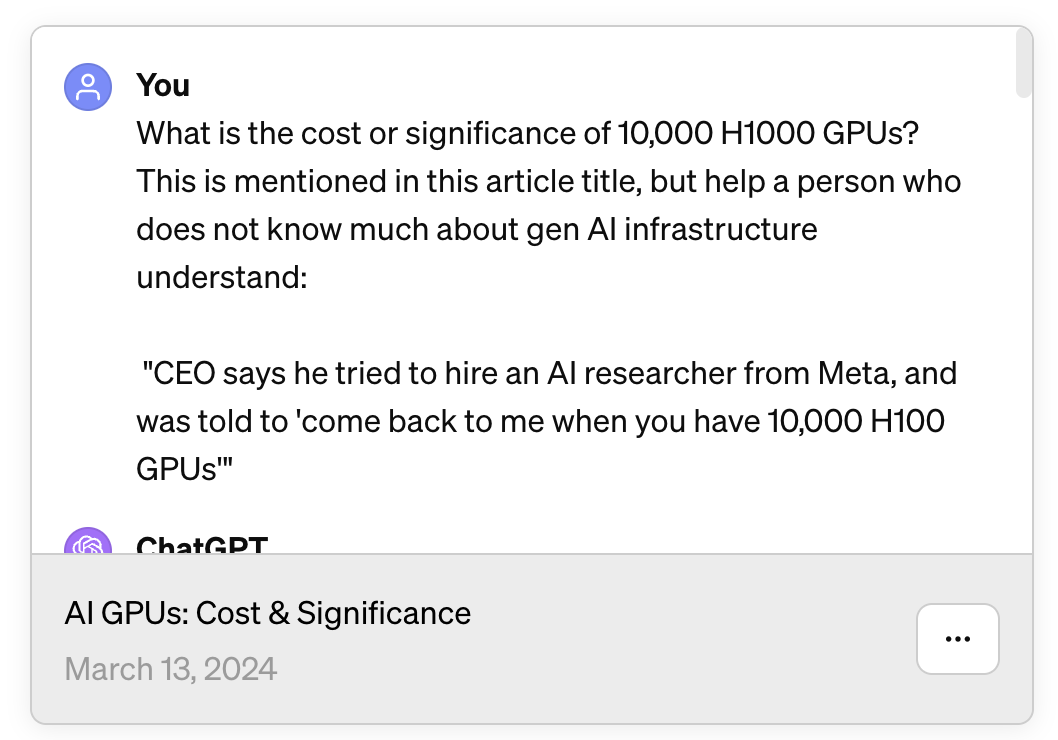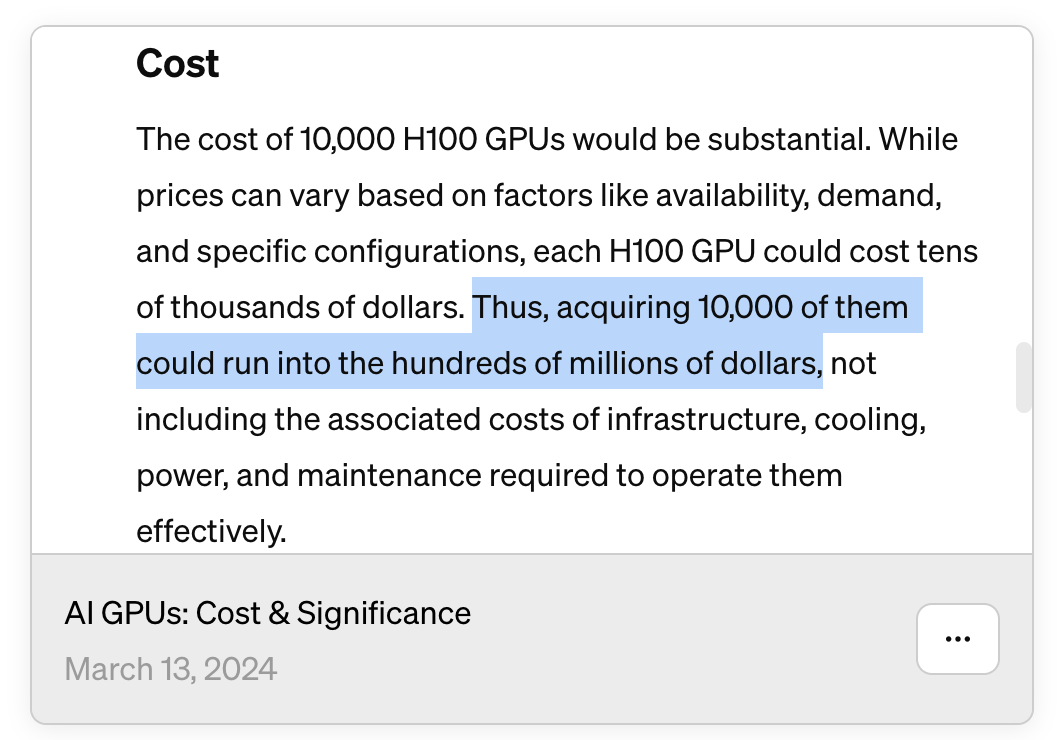Exploring Impacts of Generative AI Adoption
P.S. Lab Notes are written for and organized by Persona Types👤 persona types – we wanted to sort our content by the way people think and not across topics, because most topics are beneficial for people of all different backgrounds in product building. Our method allows for readers to hone in on what suits them, e.g. via perspective, lessons learned, or tangible actions to take. .
We’ve been diving into how Generative AI tool adoption is shaping our world, from business roadmaps to everyday processes. In this lab note I’ll be showcasing the unique impacts and resources of Generative AI that we’ve found especially noteworthy and have already discussed with some of our favorite people offline.
With all the buzz around AI, urging us to either jump on the bandwagon or approach with caution, we’re excited to share our perspective and “hot takes🥵 hot take – A straightforward or bold opinion that mirrors our in-person discussions, yet might be restrained online due to the vulnerability it brings. Hot takes are meant to be dynamic, updating as new insights arise, much like forecasting, which adapts with fresh information. We encourage you to share your thoughts through our feedback channels, inviting ongoing dialogue. “. With every lab note, we want your feedback, any amazing links you have, and your own hot takes, especially as they relate to or spin-off from this specific piece. We have a feedback form at the bottom of all of them to help us loop together, instead of furthering a writer vs reader dynamic.

1. Generative AI Adoption is on your company’s roadmap
First up, Generative AI adoption is on your company’s roadmap, or it should be. And there’s clear evidence for it, as companies are making room in the budget for expensive Generative AI infrastructure and talent. The AI budget is likely sourced from cost-savings in labor reductions and the repurposing of the record-high profit margins made from covid times. The linked article explains how Google is reallocating resources from ad-sales to generative AI, and draws the connection to layoffs. Therefore, I could not help but notice:
Hot take #1: Companies are clearing resources to support their expensive Generative AI adoption strategy. This is one reason for the aggressive layoffs in 2022-2024 and the silent sacking (driving people to quit, think “back to the office”, to avoid paying out layoff severance packages). Typically, this is executed by large tech companies restructuring their talent assets, both in people and infrastructure.
While not every company has made these rushed resource swaps, it may be only a matter of time until budgets are planned for around AI at your company. This is because every company’s agenda is to incorporate AI into their current priorities (or it should be) – either for operational efficiencies or tethered to the product they sell. There’s proof of this trend in earnings calls, with Goldman Sachs reporting that AI was mentioned in 36% of S&P 500 company calls in March of 2024, an all-time high.
In most cases, this change is likely being employed to avoid falling behind rather than it is to get ahead of competitors, because, well, everyone is behind the speed of AI.
Hot Take #2: Part of this urgency to adopt a generative AI strategy, I speculate, is from customer demand (especially B2B & enterprise contracts), nestling smartly between “machine learning” and “data intelligence” initiatives. Customer expectations are derived from competition. They are also eager to utilize generative AI in software their employees are using, hoping to optimize profit margins.
2. Emerging field of Prompt Engineering
Secondly, don’t just focus on your company’s roadmap. If you haven’t checked out Roadmap.sh, now’s the time. It breaks down tech career paths step by step, useful for both employees and employers aiming for growth and talent development.
The rise of Generative AI has sparked a demand for prompt engineers. For a closer look, the prompt engineer career roadmap offers insights into this emerging field, highlighting the journey and opportunities for those skilled in shaping AI interactions.
Prompt engineers are in the spotlight for their hilariously significant earning potential, as highlighted by Forbes. Beyond the paycheck, their role is vital across various sectors like AI research, tech products, and digital content creation, driving the need for automated solutions and intelligent interactions.
Prompt engineering has powered businesses to rapid success, blending human smarts with AI to streamline slow processes. A standout example shared on acquire.com involves founders who developed a chatbot offering tailored business growth advice:
“A chatbot that could take basic information about any business and print out industry-specific advice for how to grow it.”
After a swift setup and some smart marketing, including a nod from influencers, they earned $15,000 in just three days. This venture quickly transitioned from launch to a lucrative sale, showcasing the swift impact of skillful prompt engineering. 🤯
3. Generative AI is costly for people & the environment
As you might have guessed, Generative AI is very expensive. Before we get into some numbers about the money, we thought it would be more interesting to unbury some examples of human and environmental costs associated with Generative AI:
- AI assistants boost productivity but paradoxically risk human deskilling. AI may be the great equalizer: it can boost employee performance for the least-skilled workers, while it had less of a benefit for the high-skilled ones, even causing deskilling by increasing dependency on it.
- ChatGPT drinks a water bottle every 5-50 prompts. Dig into the environmental implications of the processing that LLM data centers require. It definitely made us want to get better at prompting.
👉 Psst, we did a deep dive into the environmental impact of Generative AI in our newsletter, The Pipette, Issue #1.
4. Generative AI infrastructure can cost 100s of millions
Lastly on the expense train: Generative AI implementation is expensive $$$$. From Google News push notification I received this morning: “CEO says he tried to hire an AI researcher from Meta, and was told ‘come back to me when you have 10,000 H100 GPUs“. Being resourceful, I went to ChatGPT and asked it to help me translate this into concrete costs:
Me: “What is the cost or significance of 10,000 H100 GPUs?”
Me: “[As] a person who does not know much about gen AI infrastructure?”
 |
 |
In the above images, did you notice that my prompt mistakenly stated H1000 instead of H100 and ChatGPT corrected me?
ChatGPT 4: “…Acquiring 10,000 of them could run into the hundreds of millions of dollars, not including the associated costs of infrastructure, cooling, power, and maintenance required to operate them effectively.”
5. We are not competing with FAANG, or other tech giants
The trend of “making room in the budget via layoffs and record profits” by tech giants highlights the steep costs involved in AI strategies. These costs seem feasible only for those with deep pockets. They also have pretty intense consequences for humans, such as instability and distrust in the tech labor force.
Hot take #3: Mimicking the AI strategies of tech behemoths isn’t just unrealistic for most; it’s an odd, expensive pursuit. Instead, the true value of Generative AI lies in its potential to impact sectors like local government, agriculture, education, and healthcare significantly.
Hot take #4: While tech giants navigate their vast resources toward AI, there’s an opportunity for professionals affected by layoffs to pivot their skills toward industries on the cusp of an AI-driven transformation. This shift promises not just to improve our daily lives but also to address challenges like cybersecurity and climate change.
Moreover, implementing Generative AI doesn’t have to break the bank. We’ve been guiding small and medium businesses (SMBs) in San Diego with services like learning to leverage AI tools such as ChatGPT and Claude for operational and marketing efficiency on a budget. Starting small with pilots ensures these tools genuinely benefit your business before scaling up.
Our Last Hot Take: Generative AI Adoption For You, Right Now
We are all searching for some tangible way that people are implementing AI. Our hope is that you think critically about the context of the trends and play to your own strengths and competitive advantages. For example, we cannot compete with tech giants with 100s of millions of dollars to throw at AI infrastructure – but there surely are ways to engage, re-skill, and encourage the people in your community.
As an example of helping the people in your community and an offline anecdote: Guess what Angela’s Dad asked for his 77th birthday this February?
Dad: “Can you teach me how to use ChatGPT … and get it on my phone?”




